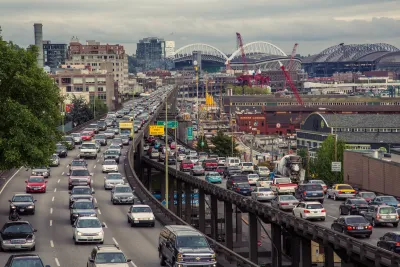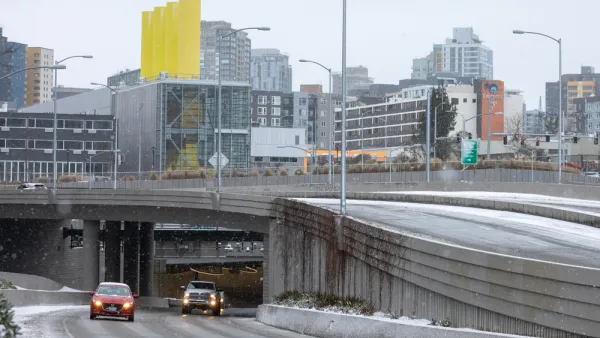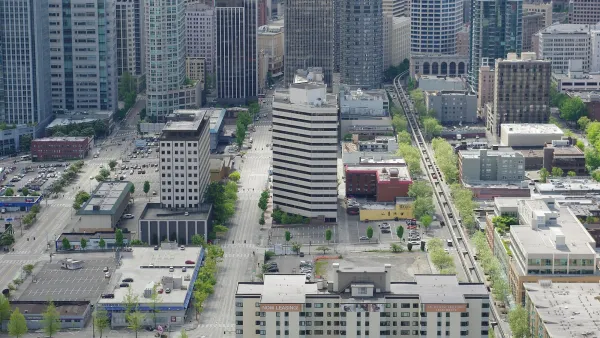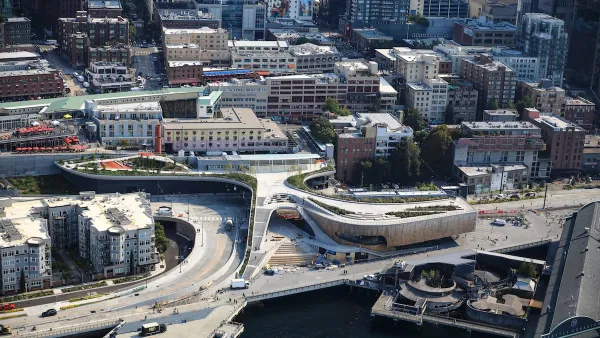Seattle recently closed the Alaskan Way Viaduct, but the predicted traffic chaos hasn’t ensued.

Joe Cortright takes a closer look at the effects of the closure of Seattle's Alaskan Way Viaduct, a roadway that handled almost 100,000 vehicle trips a day. He finds that the peak-hour traffic patterns two days in do not look that much different than typical days in the past.
In fact, some surrounding roadways look less congested — the result, says Cortright, of drivers changing or postponing trips as they adjust to the new street network:
It’s a corollary of induced demand: when we build new capacity in urban roadways, traffic grows quickly to fill it, resulting in more travel and continuing traffic jams. What we have here is “reduced demand” – when we cut the supply of urban road space, traffic volumes fall.
Cortright notes that the phenomenon of Carmageddon predictions that never play out has happened before in other cities with major road projects, including Los Angeles, Atlanta, and Minneapolis.
He adds that what happens in Seattle in coming weeks could provide important lessons about the perceived impacts of adjusting roadway capacity. "For example, this ought to be a signal that road diets, which have been shown to greatly improve safety and encourage walking and cycling, don’t have anything approaching the kinds of adverse effects on travel that highway engineers usually predict."
FULL STORY: Why Carmaggedon never comes (Seattle edition)

National Parks Layoffs Will Cause Communities to Lose Billions
Thousands of essential park workers were laid off this week, just before the busy spring break season.

Retro-silient?: America’s First “Eco-burb,” The Woodlands Turns 50
A master-planned community north of Houston offers lessons on green infrastructure and resilient design, but falls short of its founder’s lofty affordability and walkability goals.

Delivering for America Plan Will Downgrade Mail Service in at Least 49.5 Percent of Zip Codes
Republican and Democrat lawmakers criticize the plan for its disproportionate negative impact on rural communities.

Test News Post 1
This is a summary

Test News Headline 46
Test for the image on the front page.

Balancing Bombs and Butterflies: How the National Guard Protects a Rare Species
The National Guard at Fort Indiantown Gap uses GIS technology and land management strategies to balance military training with conservation efforts, ensuring the survival of the rare eastern regal fritillary butterfly.
Urban Design for Planners 1: Software Tools
This six-course series explores essential urban design concepts using open source software and equips planners with the tools they need to participate fully in the urban design process.
Planning for Universal Design
Learn the tools for implementing Universal Design in planning regulations.
EMC Planning Group, Inc.
Planetizen
Planetizen
Mpact (formerly Rail~Volution)
Great Falls Development Authority, Inc.
HUDs Office of Policy Development and Research
NYU Wagner Graduate School of Public Service





























